The state of Michigan supports a rich diversity of owls, thriving in environments that range from dense forests in the north to expansive meadows and even suburban green spaces. For bird enthusiasts and nature lovers alike, understanding the different types of owls in Michigan adds a new level of excitement to exploring the outdoors.
This guide highlights 14 distinctive owls in Michigan, covering permanent residents, occasional winter visitors, and rare migratory species. Each species has unique behaviors, preferred habitats, and fascinating adaptations suited to the Great Lakes region.
From the small and secretive Eastern Screech Owl found in neighborhoods to the striking Snowy Owl seen in open fields during winter, these remarkable birds provide wonderful opportunities for wildlife observation. Keep reading to learn about the various types of owls in Michigan, complete with helpful identification tips and interesting facts.
Different Types of Owls in Michigan
Eastern Screech Owl (Megascops asio)

The Eastern Screech Owl is a small, stocky owl that measures around 6 to 10 inches tall, making it one of Michigan’s most compact raptors. It features prominent ear tufts and comes in two distinct color morphs—gray and reddish-brown—which help it blend into tree bark seamlessly. Its eyes are large and yellow, ideal for nocturnal hunting. This owl is often heard more than seen, known for its eerie, horse-like whinny and trilling calls that echo through the night.
This species is extremely adaptable and thrives in a variety of habitats including deciduous forests, suburban parks, orchards, and even backyards with old trees. It prefers cavities in mature trees for nesting but readily accepts man-made nest boxes, making it a familiar visitor for many bird enthusiasts. They are year-round residents in Michigan and are especially well-suited to areas where humans and wooded environments overlap.
Despite its small size, the Eastern Screech Owl is a formidable predator, feeding on a wide variety of prey including insects, small rodents, birds, frogs, and even fish. One fascinating fact about this owl is its ability to remain completely still and invisible during the day, relying on its camouflage to avoid detection. When threatened, it will stretch its body and narrow its eyes to resemble a broken tree branch.
Great Horned Owl (Bubo virginianus)
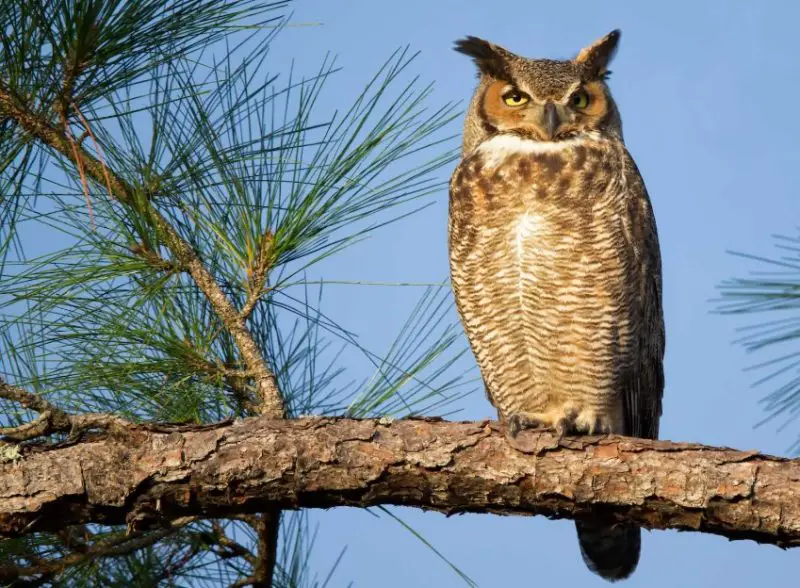
The Great Horned Owl is Michigan’s most iconic and powerful owl species. It stands between 18 to 25 inches tall and sports long, tufty “horns” that are actually feathers. With a deep, booming “hoo-hoo” call, piercing yellow eyes, and a ferocious stare, this bird commands attention. Its plumage is mottled gray-brown with white and black accents, providing excellent camouflage in a range of environments.
This owl is remarkably versatile, occupying nearly every habitat in Michigan—from dense forests and farmlands to city parks and suburban woodlands. It nests early in the year, often using abandoned nests of hawks, crows, or squirrels. In fact, Great Horned Owls are among the earliest birds to breed in the state, sometimes laying eggs as early as January even when snow is still heavy on the ground.
The Great Horned Owl is a top predator with one of the broadest diets among owls. It will hunt skunks, rabbits, birds, snakes, and even other raptors. A particularly impressive trait is its ability to crush prey with 300 pounds per square inch of force. Despite their fierce reputation, these owls are essential for ecosystem balance, helping control populations of rodents and other small mammals.
Barred Owl (Strix varia)
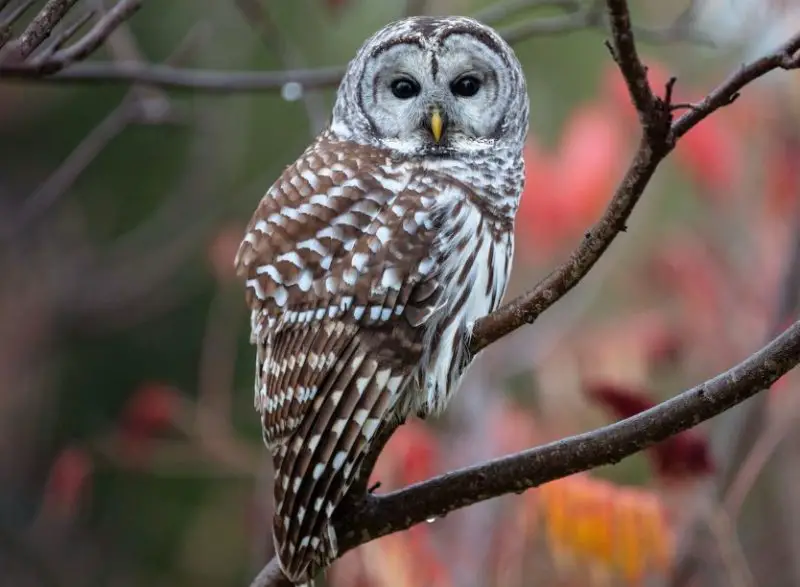
The Barred Owl is a medium-to-large-sized owl, easily recognized by its round head, lack of ear tufts, and deep brown eyes—uncommon among North American owls. Its name comes from the horizontal “bars” of brown and white across its chest and vertical streaking on its belly. The Barred Owl has a very distinctive call that sounds like “Who cooks for you? Who cooks for you all?”—a vocalization that often echoes through wooded areas.
This species prefers old, mature forests with access to water, making the wetlands, river valleys, and swampy woodlands of Michigan ideal habitat. It is a year-round resident in the state and often remains in the same territory for life. These owls nest in tree cavities or use old hawk or squirrel nests, and their presence is usually noted by their loud, resonant calls at dawn or dusk.
Barred Owls hunt by watching quietly from perches and swooping down on prey with incredible stealth. They feed on small mammals, amphibians, reptiles, and occasionally fish. One fascinating behavior is their habit of calling during the day, especially on overcast days, which is unusual for most owls. Although generally shy, they can become quite vocal and even curious when approached by humans in their territory.
Northern Saw-whet Owl (Aegolius acadicus)
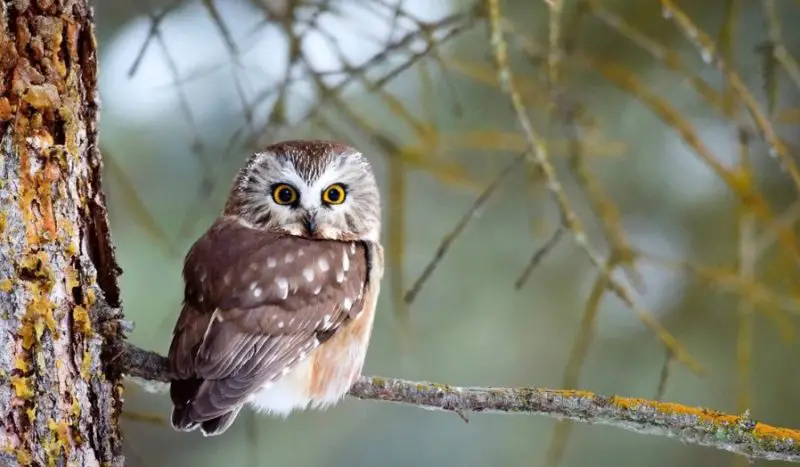
The Northern Saw-whet Owl is one of the smallest and most secretive owls in Michigan, measuring only about 7 to 8 inches tall. It has a rounded head, large golden eyes, and no ear tufts. Its name comes from its repetitive, high-pitched call that resembles the sound of a saw being sharpened. These owls are difficult to spot due to their nocturnal habits and excellent camouflage, often roosting silently in dense conifers during the day.
In Michigan, the Northern Saw-whet Owl is found mostly during migration and winter months, although some may breed in the northern parts of the state. Their preferred habitats include mixed or coniferous forests, especially those with thick understory for daytime concealment. During fall migration, they are sometimes captured and banded at owl monitoring stations, providing researchers with insights into their elusive lives.
These owls hunt small rodents like mice and shrews, but they also eat birds and insects when available. Despite their size, they are aggressive hunters. A fun fact: they often store surplus food in tree branches or cavities during winter to eat later when prey is scarce. Because of their secretive nature and diminutive size, sightings are considered a treat for birdwatchers.
Snowy Owl (Bubo scandiacus)
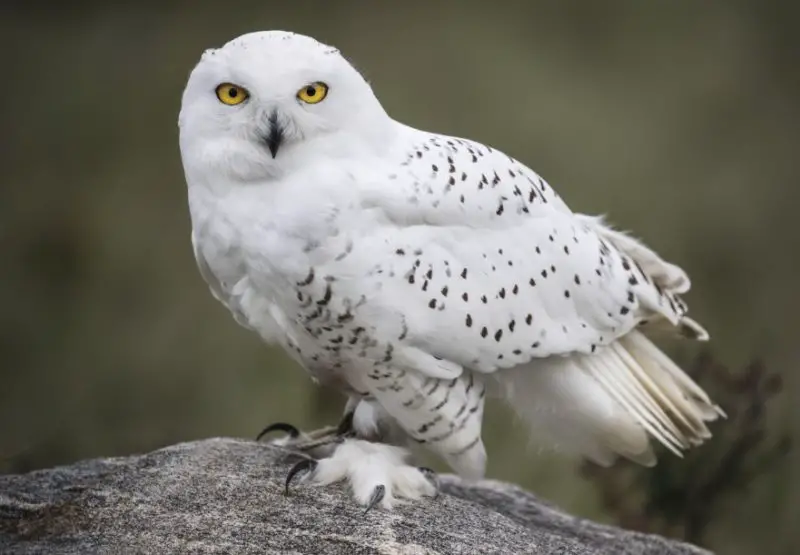
The Snowy Owl is one of the most visually striking owls in Michigan, known for its large size and pure white plumage accented with dark markings. Adult males are nearly all white, while females and younger birds show more barring. These owls have bright yellow eyes and rounded heads without ear tufts, giving them a regal, ghostly appearance. With wingspans up to 5.5 feet, they are among the largest owls in North America.
Snowy Owls are winter visitors to Michigan, arriving from the Arctic tundra during irruptive years—when prey is scarce up north and large numbers migrate farther south. They favor open landscapes that mimic the tundra, such as airports, beaches, frozen fields, and lake shores. The flat, open terrain of Michigan’s farmland and Great Lakes coastline provides an ideal temporary home during these months.
Unlike most owls, Snowy Owls are diurnal and often hunt during the day, especially at dawn and dusk. Their primary prey is voles and lemmings, but in Michigan, they may feed on small mammals, ducks, and birds. A fascinating note: their presence often sparks a wave of excitement in the birding community, with sightings carefully tracked across the state. Despite their calm appearance, they are fierce hunters, using keen eyesight and powerful talons to catch prey.
Long-eared Owl (Asio otus)
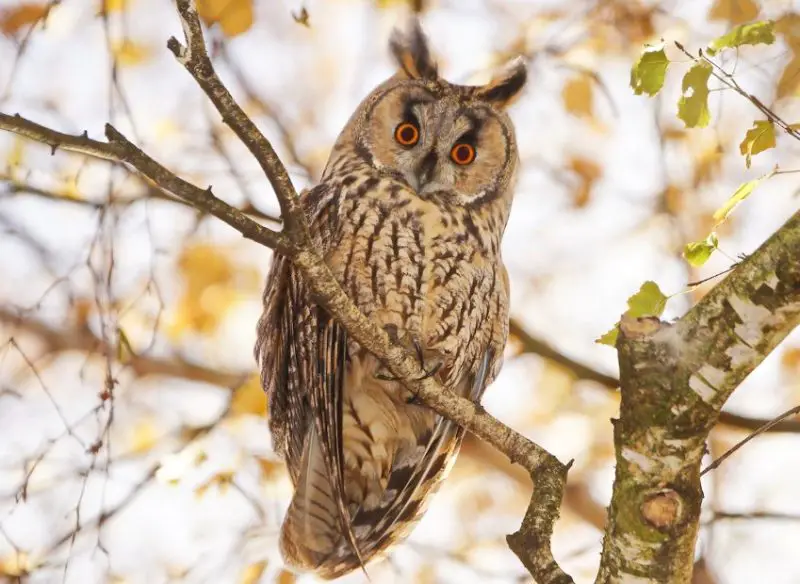
The Long-eared Owl is a medium-sized owl with long, narrow ear tufts that sit close together on the top of its head, giving it a very alert and upright appearance. Its plumage is mottled brown, buff, and black, providing excellent camouflage among conifer branches. The bird’s face is marked with a striking orange facial disk and piercing yellow eyes, and it can grow to about 13 to 16 inches in height.
This owl is primarily a winter visitor to Michigan, especially in southern regions of the state. It prefers dense woodlands near open areas, where it can roost in thick foliage during the day and hunt in nearby fields at night. During the cold months, they often gather in small communal roosts in dense pine groves or cedar swamps—sometimes with several individuals sharing the same tree.
Long-eared Owls are nocturnal and feed mostly on small mammals like voles and mice, which they locate by sound thanks to their highly sensitive ears. One interesting behavior is their quiet, low-hooted call, often only heard during the breeding season. Though not easy to spot due to their shy nature and secretive roosts, finding a group of them in winter is a memorable experience for birders.
Short-eared Owl (Asio flammeus)
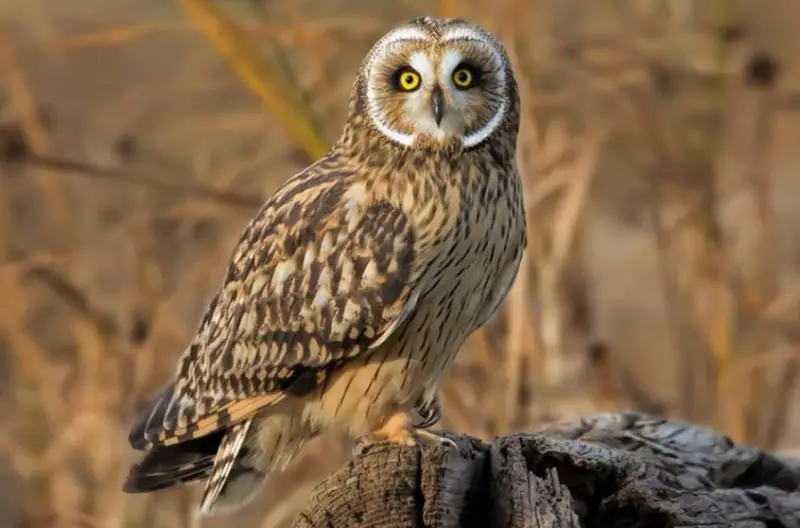
The Short-eared Owl is a medium-sized owl with rounded wings, a pale facial disk, and very short, often invisible ear tufts. It has a buff-colored body with dark streaks and black-rimmed yellow eyes that give it a perpetually intense expression. This owl has a buoyant, moth-like flight style that makes it easily recognizable in open country.
In Michigan, the Short-eared Owl is most commonly found in winter and during migration in wide-open habitats such as prairies, grasslands, marshes, and agricultural fields. Unlike many owls, this species is active during the day—particularly around dawn and dusk—making it easier to observe than other owls. It often hunts by flying low over the ground in search of small mammals like voles.
Short-eared Owls are highly nomadic, often shifting locations depending on prey availability. They are known to nest on the ground in northern parts of North America, but in Michigan they are primarily winter visitors. One fascinating fact is that their populations fluctuate dramatically depending on the abundance of rodents, and in years of high prey density, they may appear in large numbers.
Northern Hawk Owl (Surnia ulula)
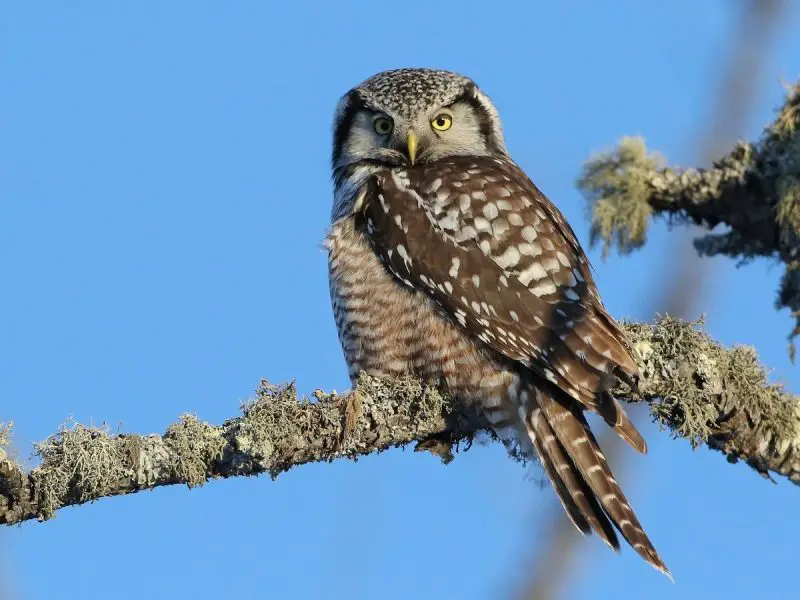
The Northern Hawk Owl is a rare but captivating visitor to Michigan, especially during irruptive winters when food sources become scarce in Canada. This owl is medium-sized with a long tail, flat head, and no ear tufts. It has a white face bordered by black and dark barring across its chest and belly. As its name suggests, it resembles a hawk in both appearance and hunting behavior.
Unlike most owls, the Northern Hawk Owl is primarily diurnal and can often be seen perched atop tall trees or telephone poles during the day, scanning for prey. It prefers open boreal forests, clearings, and burned areas, and when it visits Michigan, it’s usually in the Upper Peninsula or the northern Lower Peninsula during winter months. Sightings are rare but memorable, often drawing attention from birdwatchers across the region.
These owls hunt small mammals and birds with exceptional visual acuity and have been observed diving on prey from great heights. One fun fact is their ability to detect prey under snow from as far as 100 feet away. Because they are so rare in Michigan, any confirmed sighting is considered a highlight of the winter birding season.
Boreal Owl (Aegolius funereus)
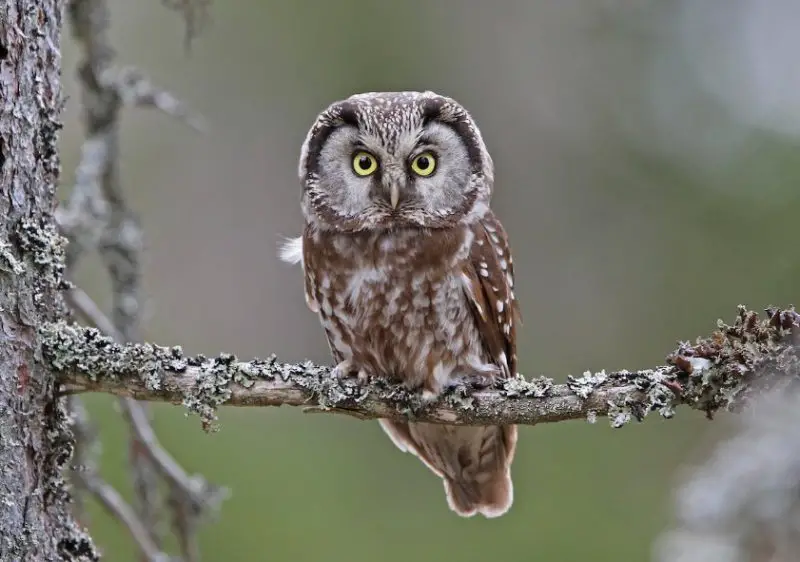
The Boreal Owl is a small, elusive owl species that resides primarily in the dense boreal forests of Canada and Alaska but occasionally appears in Michigan’s northern forests during the winter. It is about 8 to 11 inches in size, with a rounded head, pale facial disk, and large yellow eyes. It lacks ear tufts, giving it a soft, rounded silhouette that adds to its ghostly appearance in low light.
In Michigan, sightings of Boreal Owls are extremely rare and typically limited to the Upper Peninsula during irruption years or cold winters. They prefer mature coniferous forests with little human disturbance, where they roost quietly during the day. Because of their secretive behavior and remote habitat, even experienced birders may go years without encountering one.
Boreal Owls are strictly nocturnal and feed on small rodents, birds, and insects. Their call is a repetitive, soft “toot” that can carry long distances in the still winter air. These owls are cavity nesters and often rely on old woodpecker holes for breeding sites. Despite their rarity, Boreal Owls are a prized find for dedicated owl survey teams and northern birdwatchers.
Barn Owl (Tyto furcata)
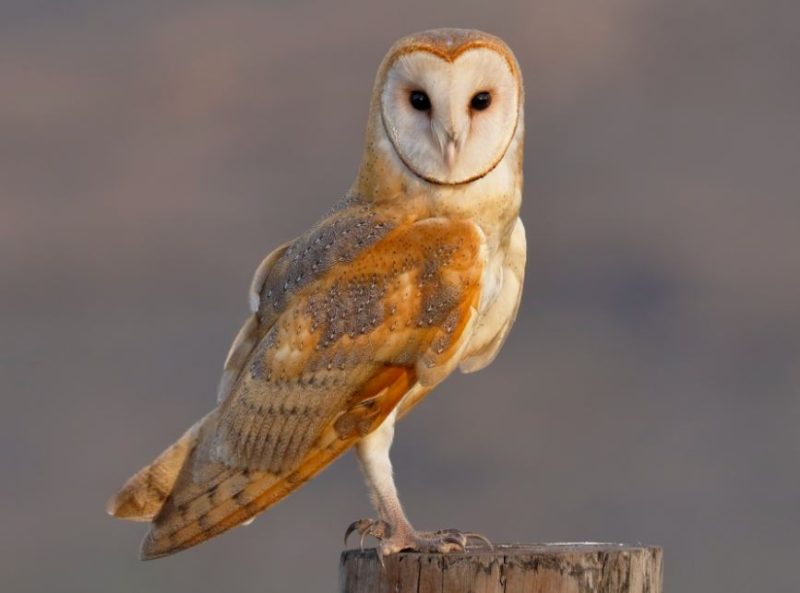
The Barn Owl is a pale, medium-sized owl with a distinctive heart-shaped facial disk, dark eyes, and long legs. Its plumage is golden-buff above and white below, giving it a ghostly appearance as it flies silently through the night. This species is one of the most widely distributed owls in the world but is quite rare in Michigan due to its sensitivity to cold climates and habitat limitations.
In Michigan, Barn Owls are most often reported from the southern part of the Lower Peninsula, especially in rural areas with access to open grasslands and old barns or abandoned buildings where they can roost and nest. Because Michigan winters are harsh and long, these owls have difficulty establishing stable populations, and most reports are of lone individuals during warmer months.
Barn Owls are excellent rodent hunters, using their acute sense of hearing to locate prey in total darkness. They are known for their eerie, raspy screeches rather than hoots, which can startle anyone unfamiliar with them. A fascinating fact: a single Barn Owl can eat over 1,000 mice in a single breeding season, making them valuable allies in agricultural pest control. However, conservation efforts are needed to maintain their presence in Michigan.
Great Gray Owl (Strix nebulosa)
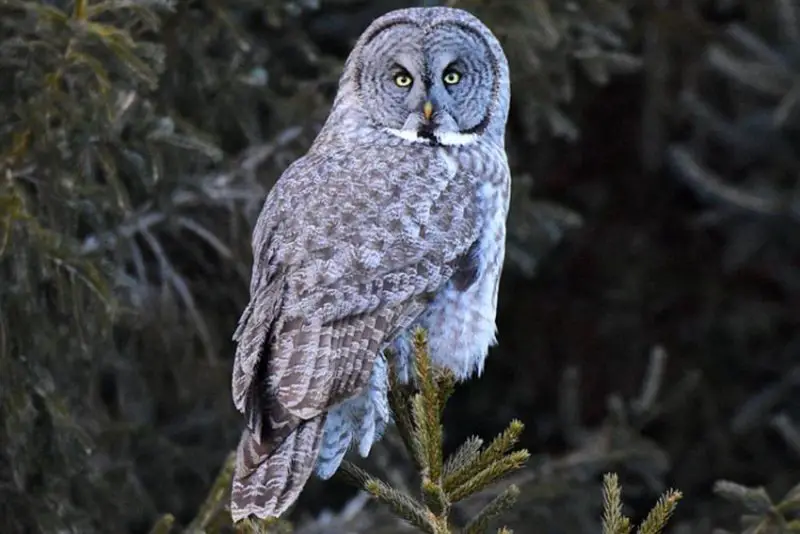
The Great Gray Owl is one of the largest owls in North America by length, reaching up to 33 inches tall with a wingspan of nearly 5 feet. It has a distinctive round face with concentric gray rings, small yellow eyes, and a white “bow tie” marking on its throat. Despite its size, it’s surprisingly light due to fluffy feathers and a relatively small body mass.
In Michigan, the Great Gray Owl is an extremely rare winter visitor, typically seen only in the Upper Peninsula during irruption years when food becomes scarce farther north. It favors dense coniferous forests and boggy lowlands, often near open clearings or meadows where it hunts for voles and other small mammals beneath the snow.
This owl is known for its ghostlike silence in flight and its ability to detect prey hidden beneath deep snow. Unlike most owls, it often hunts during daylight hours. A fascinating fact is that it can plunge through snow as deep as 18 inches to catch rodents. Birders who manage to see one in Michigan regard it as a once-in-a-lifetime sighting.
Burrowing Owl (Athene cunicularia)
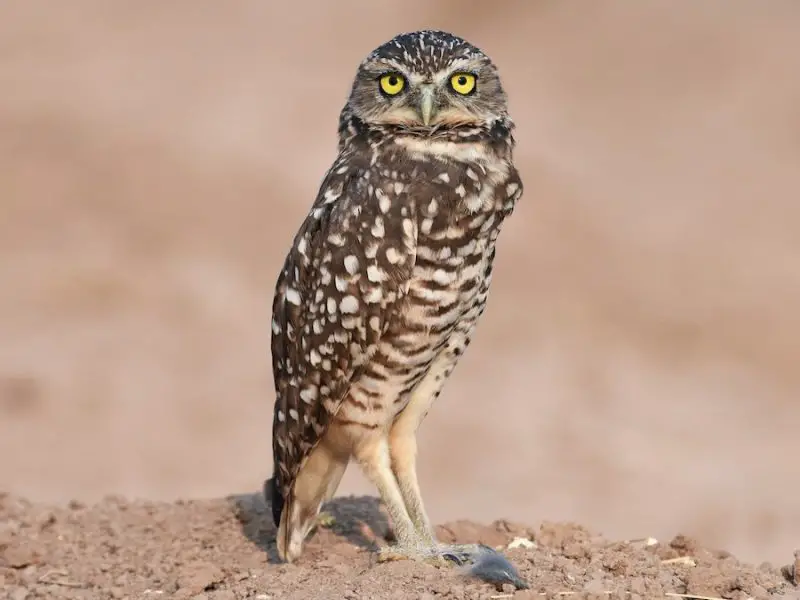
The Burrowing Owl is a small, long-legged owl with bright yellow eyes, a flat facial disk, and a short tail. Unlike most owls, it is active during the day and is often seen standing upright on the ground or on low perches. Its plumage is sandy brown with white spotting, ideal for blending into open prairie or scrub habitats.
In Michigan, the Burrowing Owl is considered extremely rare and primarily shows up as a vagrant in the southern parts of the state. There are only a handful of confirmed sightings, and these are usually in open agricultural lands or disturbed grasslands, far from their typical western and southern breeding ranges. They nest in burrows, often those abandoned by ground squirrels or prairie dogs—something Michigan’s landscape largely lacks.
Burrowing Owls are highly social and often seen in small colonies elsewhere in their range. They bob their heads when threatened and will mimic the hiss of a rattlesnake to deter predators. Their quirky behaviors, diurnal activity, and rarity make them a sought-after but seldom-seen species for Michigan birders.
Spotted Owl (Strix occidentalis)
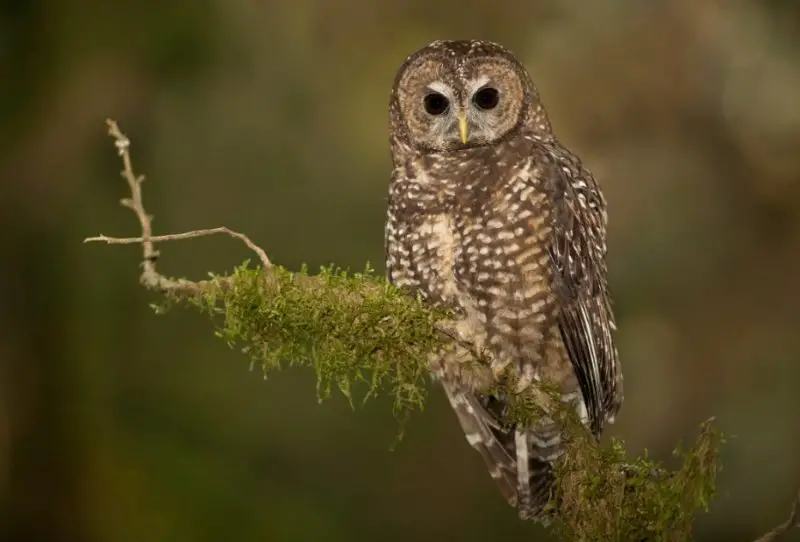
The Spotted Owl is a medium-to-large owl with a rounded head, dark eyes, and brown plumage marked with white spots. Its facial disk is pale with dark borders, and it lacks ear tufts, giving it a soft, classic owl silhouette. This species is closely associated with old-growth forests, especially in the western United States.
In Michigan, the Spotted Owl is not a resident species and has no established populations. It is considered a rare vagrant, with only a few unconfirmed or extremely rare records in the historical database. Most sightings are likely misidentifications or escaped captive birds, as its known range is in the Pacific Northwest and parts of the Southwest.
The Spotted Owl is famous in conservation circles due to its decline from habitat loss and competition with the invasive Barred Owl. While it is not expected to occur naturally in Michigan, its conservation story underscores the broader importance of protecting owl habitats nationwide. Any verified appearance in Michigan would be extraordinary and subject to rigorous scrutiny.
Migratory Long-eared Owl (Asio otus)
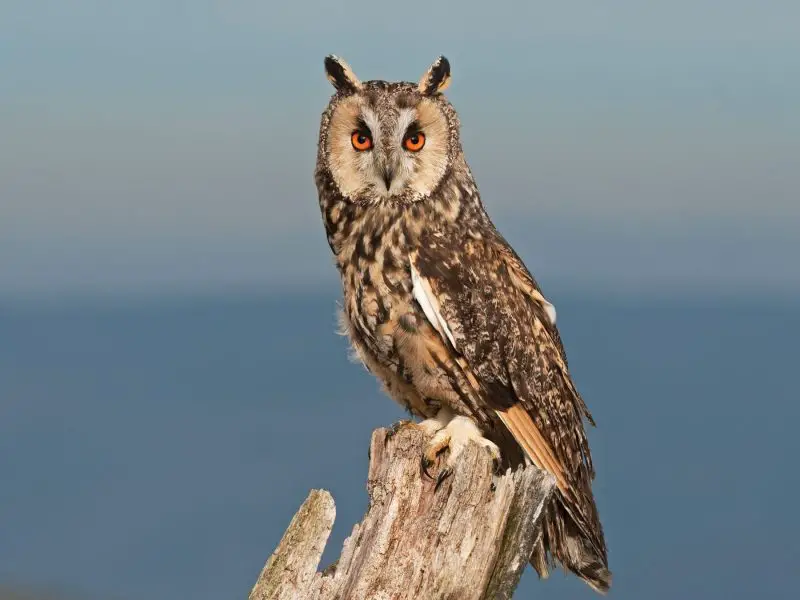
The Long-eared Owl is a slender, medium-sized owl with prominent ear tufts, a long tail, and rich, mottled brown plumage. Its facial disk is orange-rust with black borders, giving it a wide-eyed, intense expression. Although Long-eared Owls breed in the northern Great Lakes and Canada, a migratory population regularly passes through Michigan during spring and fall. These owls prefer roosting in dense evergreens or overgrown thickets during migration, staying well-hidden and silent during the day.
In Michigan, they are most often observed as migrants in March–April and again in October–November, particularly in southern and central parts of the state. Though not known to breed widely in Michigan, a few have attempted nesting in the Upper Peninsula. Their preferred habitats during stopovers include mixed woodlands near open areas for hunting. They primarily feed on small mammals like voles, mice, and sometimes small birds, hunting silently in the dusk or early morning hours.
A fascinating behavior of Long-eared Owls is their tendency to form communal winter roosts, sometimes with dozens clustered together in one patch of trees—a rare treat for birders. Despite their secrecy and camouflage, experienced birdwatchers can spot them during migration by carefully scanning dense pine groves. Their eerie, low-pitched hoots are often the only clue to their presence, and they remain one of Michigan’s most intriguing and elusive migratory owls.






